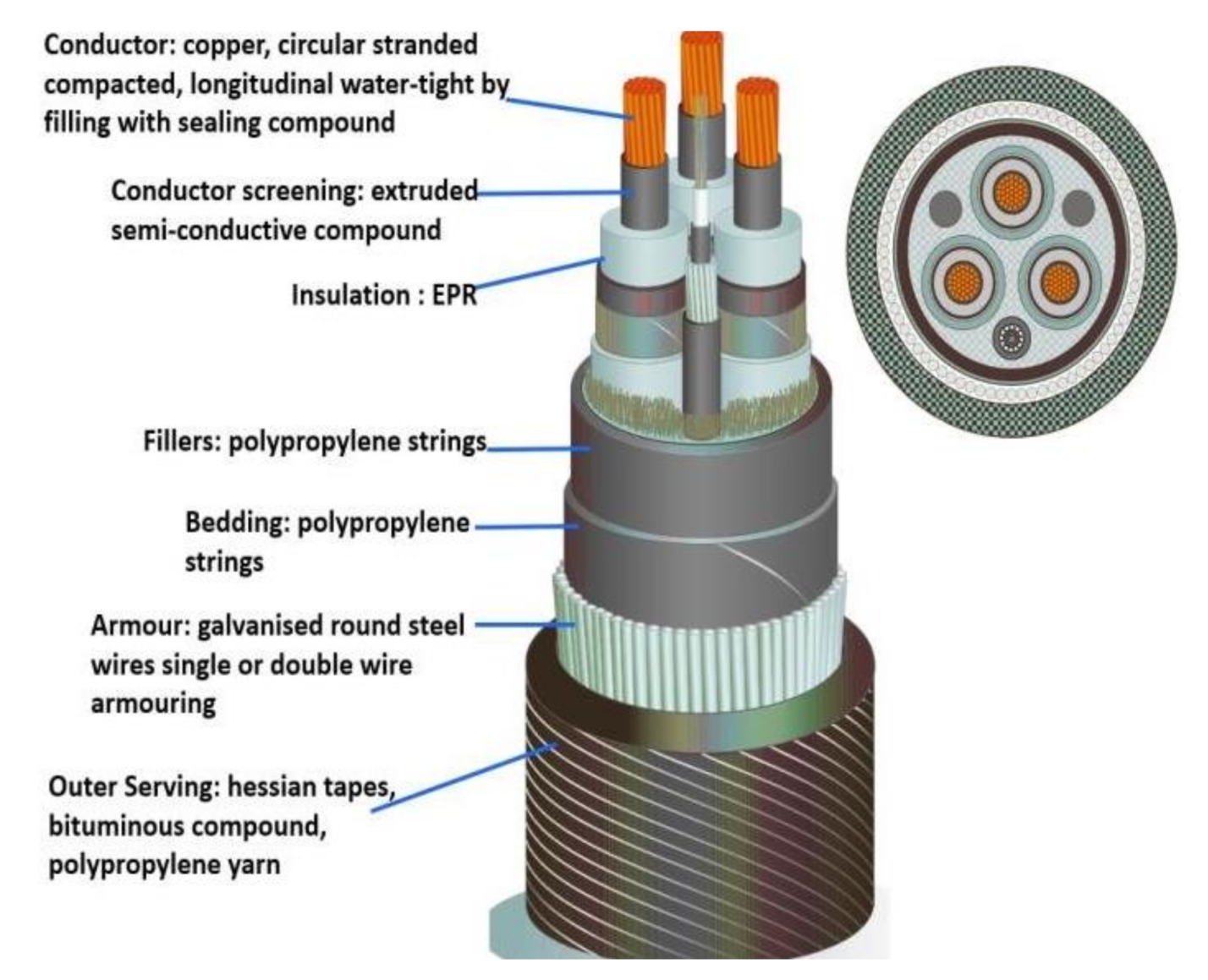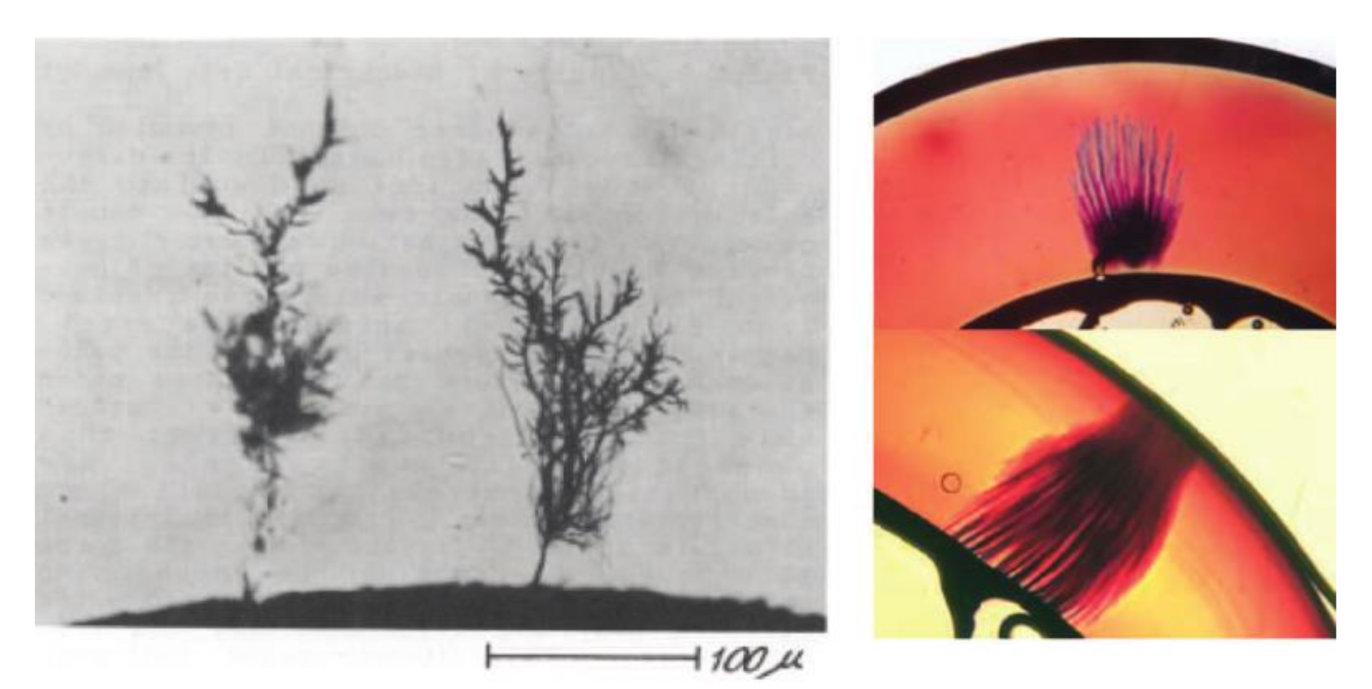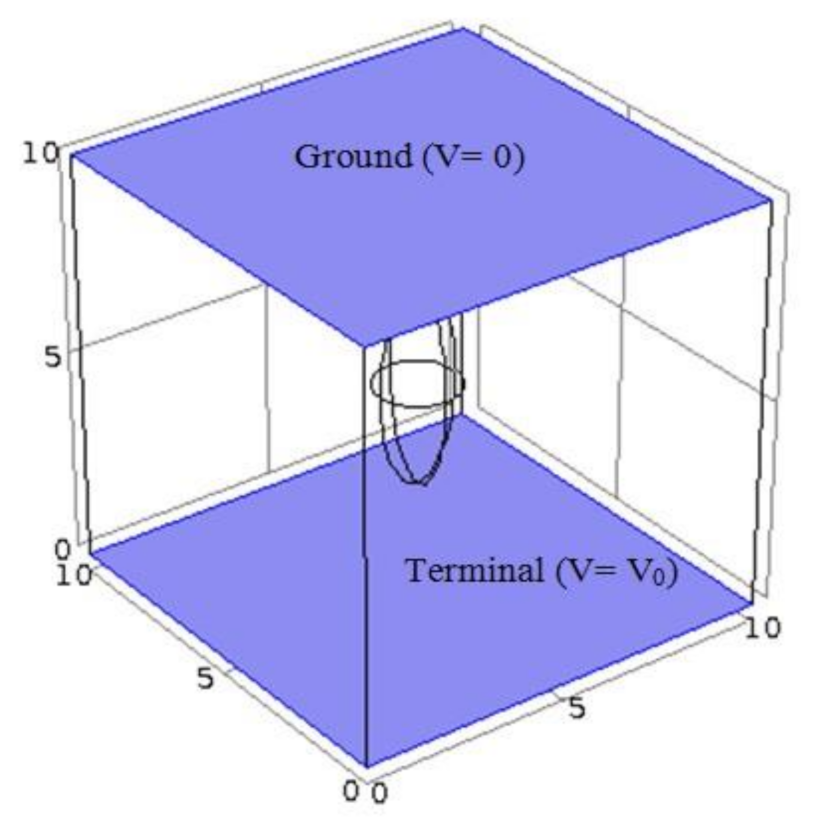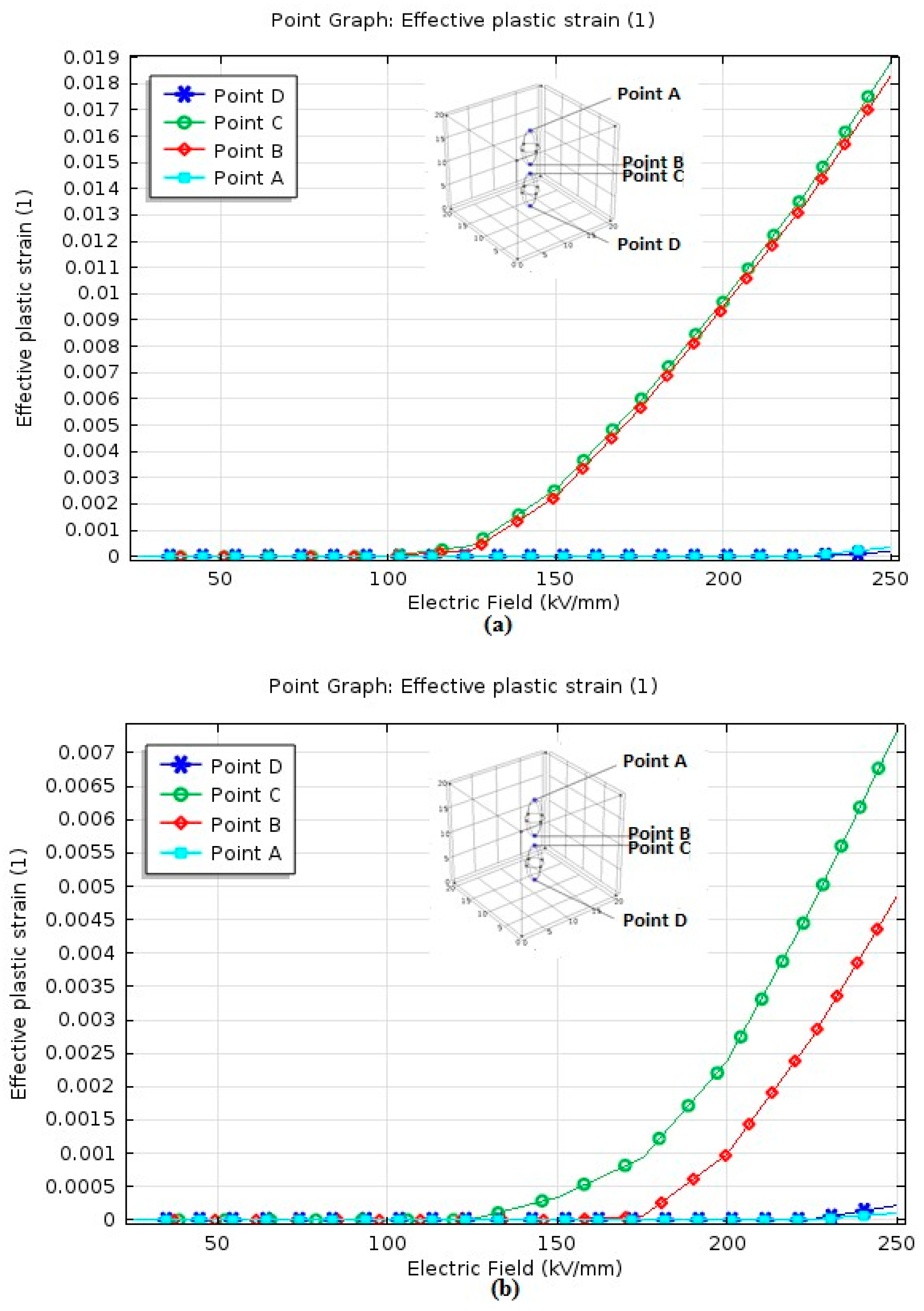1. Introduction
Offshore energy is a potentially promising source of renewable energy and extensive work has been devoted to suggest reliable structures that can withstand harsh environments while ensuring reliable delivery of electricity to onshore electric power stations [
1,
2,
3,
4,
5]. Submarine power cables are deployed to work in extreme environmental conditions for a lifetime of 20 to 25 years [
5]. A large number of elements are required to form the complex structure of a submarine power cable (
Figure 1, [
6]). The investment required for operation and maintenance of submarine power cables is substantial. Therefore, efficient methods are necessary to predict the lifetime of cables [
5]. Among the various constituents of a submarine power cable, the insulator surrounding the conductor is an integral component and regular monitoring of the insulator is important to prevent a breakdown. At the advent of submarine power cables, oil–paper insulation was initially used. However, from the early 1960s, cross-linked polyethylene (XLPE) became the most preferred insulator material because of its better electrical and mechanical performance [
7,
8,
9,
10]. Although the demand of XLPE as an insulator material remains high, the lifetime of cables is significantly reduced by the presence of water trees in the insulator. Water trees are a permanent degradation structure and are composed of very small voids (i.e., of a few nanometers). The amount of water absorbed in field-aged cables has been found to be approximately 0.5–2% of the total insulation volume. The operational and material factors of cables are considered to influence the growth rate of water trees. Operational factors are those factors that are independent of the insulating material and include electrical stress, frequency, temperature, and aging time. Material factors are the internal physical and chemical properties of water trees, and geometrical parameters [
11].
The initiation and growth of water trees depends largely on the electric field and water content [
12]. A non-uniform electric field and the polarization effect shapes the water voids into ellipsoids [
13]. Therefore, water voids are usually modelled as ellipsoids in numerical studies. The application of an electric field induces high Maxwell stress near the tips of ellipsoidal water voids, resulting in their deformation. According to [
14], moderate electric fields of 10–50 KV/mm do not cause permanent deformation of water voids, whereas [
15] proved that electric fields above 100 KV/mm cause plastic deformation. Therefore, in our study an electric field of 50–200 KV/mm was applied to evaluate the effective plastic strain generated at the tips of water voids. In relation to a numerical study of water treeing in power cable insulation from a mechanical point of view, [
16,
17] reported that fatigue of the insulation caused by dielectrophoretic stresses around the voids might lead to the growth of water trees. According to [
18] the growth of water trees proceeds by the interconnection of ellipsoidal-shaped voids. Degradation has been modeled as a cubic cell with cylindrical channels and ellipsoidal inclusions filled with water, and dielectric properties have been studied under the effect of Maxwell stress [
19].
The major steps involved in the growth of water trees are represented in
Figure 2 and
Figure 3. Voids are the inception points for water trees. Some voids are present in the cable at the end of the extrusion process. When submarine cables are in operation, water molecules enter these voids because of excess humidity. Based on numerous studies of the possible mechanisms involved in the growth of water trees, electric fields have been found to be the most significant influence on the growth of water trees in insulators. The forces resulting from the high electric field at the tips of the voids cause plastic deformation and subsequently lead to the formation of interconnecting channels between the voids. After initiation, water trees begin to propagate towards the conductor, leading to its corrosion and ultimately damaging the cable.
In this article, a 3D finite element model of a water void in an insulator is developed using COMSOL Multiphysics software. Although it would be of significant interest, experimental study of the ageing of insulators due to water tree propagation is impractical due to the extremely long ageing experiment time that would be required. Thus, the current study instead aims to widen the comprehension of this kind of ageing using numerical modeling. In this study, the water void was modelled as an ellipsoid in a cubic cell in reference to the model of [
19]. The main objectives of this study are to: (1) calculate the displacement of a single water void in a cubic cell with respect to applied voltage; (2) determine the influence of relative distance between two water voids and applied voltage on the void’s displacement; and (3) to study the plastic deformation of water voids in accordance to the von Mises yielding criterion. The first section of this article describes the electromechanics module of COMSOL Multiphysics, which was the main computer tool used in this study. It should be noted that few previous studies have been conducted pertaining to the current topic, thus the presented simulation results cannot be compared to the literature. Therefore, we would like to emphasize that the current results should be viewed as introductory and an inspiration for future research.
3. Results and Discussion
A number of simulations were carried out to study the deformation of water voids under the effect of an applied electric field. Electric field enhancement at the tips of ellipsoids has been reported in previous studies [
16,
17]. The growth of these ellipsoids and the merging of neighboring ellipsoids is the cause of degradation of the insulator material in the form of water treeing, and ultimately the material’s breakdown. These interconnections of ellipsoids (i.e., water voids) to form a water tree is a complex phenomenon that involves several factors, the most significant of which is the electric field [
18]. In addition to the electric field, the distance between the tips of ellipsoids has also been found to be an important factor in the degradation of the insulator material.
As stated previously, the applied electric field was varied between 50 and 250 kV/mm. Voids in an insulator can be of different shape and size. Furthermore, corresponding to the void’s aspect ratio, the electric field is amplified at the void’s tip. The voids suffer maximum deformation when they are aligned in the direction of the electric field. In order to review the maximum deformation an applied electric field causes instability of the water molecules present inside the ellipsoids, causing them to deform in areas in which the geometry of the ellipsoids is most favorable. The deformation is expressed in the form of displacement encountered at the tips of the ellipsoids.
Figure 11 is a graphical representation of the deformation suffered at the tips. It is clear from this figure that the ellipsoid experiences maximum displacement (i.e., deformation). The rate of deformation of ellipsoids is not constant because ellipsoids with varying aspect ratios deform differently. In an increasing electric field
Figure 12, the instability of water molecules increases resulting in greater displacement of the tips of the ellipsoid.
The merging of voids involves permanent deformation of localized zones present between voids. A material suffers permanent deformation when it attains or crosses yield stress due to an external load. Although several yielding criteria describing the failure of materials exist, von Mises stress or von Mises yield criterion was used in this study because it simplifies the understanding of the physics behind the interconnection of voids that leads to the propagation of water trees. The applied electric field is the only loading condition that causes Maxwell stress along the surface of voids. Von Mises stress is calculated using the Maxwell stress tensor.
Increasing the applied electric field increases von Mises stress, particularly at ellipsoid tips as shown in
Figure 13 and
Figure 14. This increment of von Mises stress is due to an increase in the induced Maxwell stress. Of note, this plot shows that the von Mises stress surpasses the yield strength of XLPE at an approximate electric field of 200 kV/mm.
Voids experience permanent deformation when Von Mises stress reaches a critical value of 18 MPa at an electric field of 200 kV/mm (
Figure 14). Plastic deformation is initiated at 200 kV/mm and increases at a constant rate with an increase in the applied electric field. At this stage, formation of channels between voids is initiated. These channels bridge the voids, thus forming a bigger water tree structure inside the insulator.
Modeling of one water void in a cubic cell of 10 × 10 × 10 µm was followed by a model of two water voids in a cubic cell of 20 × 20 × 20 µm (
Figure 15). Both the geometrical and material parameters of the water voids are identical. The water voids can be present randomly inside the cubic cell; however, in this study the water voids were aligned in the direction of the electric field and placed adjacent to each other. The water voids suffer maximum deformation when they are in the direction of electric field.
Figure 16 shows that the displacement of the tips of two neighboring ellipsoids depends on the relative distance between the two and on the electric field. As observed in the model of one water void in
Figure 12, displacement increases with an increase in the applied electric field in the two water void model, as shown in
Figure 16a–c.
It can be noted from these figures that displacement increases with decreasing relative distance between voids (
Figure 16b,c), whereas
Figure 16a shows there is some dissimilarity in displacement of the points A, B, C, and D. The reason for this dissimilarity might be that a relative distance of 0.5 µm between voids at an applied electric field of around 200 kV/mm is sufficient to cause immediate coalescence of voids. Electric field enhancement is greater at points B and C of the two ellipsoids compared to points A and C; therefore, points B and C experience higher deformation compared to the points that are further apart from each other.
As mentioned, the von Mises yielding criterion was used to study material failure under external load of an applied electric field. Similar to the case of the single water void model, an increase in the applied electric field increases von Mises stress. The important difference between the two models is the influence of relative distance between the two voids on von Mises stress. It can be inferred from
Figure 17 that Von Mises stress acts predominantly at the two adjacent tips (points B and C), rather than at point A and point D. It can also be comprehended from
Figure 17 that decreasing the relative distance between voids increases the Maxwell surface stress and also enhances the influence of electric fields between two adjacent tips. These circumstances lead to quick failure of the zones between voids and the creation of channels. A decrease in the relative distance from 2 to 0.5 µm intensifies von Mises stress by approximately 3 times at the same voltage. It should be noted that increasing the aspect ratio of ellipsoids will significantly amplify the stresses at their tip.
The consequence of increasing Von Mises stress with increasing applied electric field is attainment of plastic deformation when the yielding stress of material is reached.
Figure 18 demonstrates the important relationship between the relative distance of voids and electric field at which the tips of voids suffer from plastic deformation. At a relative distance of 0.5 µm, plastic deformation initiates in the zone close to void tips at an approximate electric field of 100 kV/mm; however, at a relative distance of 2 µm, initiation of plastic deformation is delayed until the applied electric field is around 200 kV/mm.
One of the main objectives in this study is to observe plastic deformation initiating at the tips of voids due to an electric field.
Figure 19 depicts the plastic deformation caused by high von Mises stress obtained from the influence of an amplified electric field at the tips of voids. To provide a clear visualization of the mechanisms involved in the plastic deformation of voids, the figure is scaled and is thus not an absolute representation of the effective plastic strain.
Figure 19 shows how the tips of water voids attain plasticity with increasing electric field, ultimately leading to coalescence of the two voids by the creation of a channel between them. When the tips of the void attain plasticity, the neighboring zone is affected, thus causing localized damage.
With the increase in the electric field the localized damage zone expands, thus accelerating the merging of the voids. This preliminary model is promising because it provides clear insights into XPLE ageing, which is extremely difficult to model experimentally due to the ageing time needed.


























